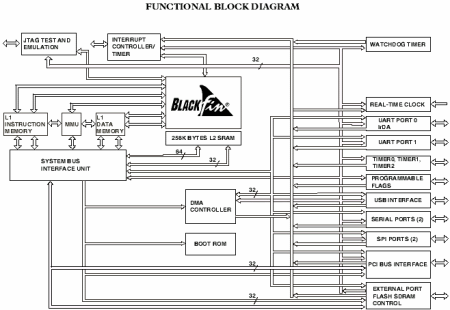Another native-DSP Linux port — this one to ADI’s Blackfin
Nov 6, 2003 — by LinuxDevices Staff — from the LinuxDevices Archive — 14 viewsWe asked the question “World's first native-DSP Linux port?” and an astute reader dropped us an email with news of another native-DSP Linux port — one to Analog Devices Inc.'s (ADI's) Blackfin DSP. Without splitting hairs on which one of the two native-DSP ports came first (it probably depends on how you define “came first”), we thought we'd provide details on this additional native-DSP Linux option.
News of the Blackfin port quietly appeared on the uclinux.org website one week ago, ahead of yesterday's announcement by Softier of “MediaLinux” for TI's DM64x DSP. The port apparently originated with Lineo prior to its acquisition by Metrowerks, and has been continuing as a project at Metrowerks.
Like Softier's native-DSP Linux, the Blackfin uClinux runs natively on a single-core DSP. Single-core DSPs are less costly to manufacture than dual-core (DSP/RISC) processors, because they require fewer transistors and thus more of them can be produced on a single silicon wafer. In fact, ADI says its Blackfin DSPs cost 50% less than typical dual-core DSPs, and its Blackfin processors are offered in a number of configurations ranging between $5 and $32 (at 10,000 units).
ADI's single-core Blackfin DSP takes a different approach than the TI single-core DM64x DSPs supported by Softier's Linux implementation. Whereas the TI chips combine DSP functions with VLIW (very long instruction word) architecture for general purposes functions, the Blackfin DSPs employ a RISC (reduced instruction set computer) architecture approach. Specifically, ADI describes the Blackfin as having a “RISC-like register and instruction model” for general purpose functions in addition to “single-instruction, multiple-data (SIMD) multimedia capabilities” for signal processing. Another key difference is the presence of an MMU (memory management unit) in the Blackfin DSP (see block diagram below).

Analog Devices Blackfin DSP architecture
Highly integrated system-on-chip (SoC) designs such as the ADI Blackfin and TI DM64x can not only reduce cost, but they can also significantly reduce power consumption. Blackfin DSPs support dynamic power management (DPM) — independent adjustment of both voltage and frequency — through an integrated, software programmable Voltage Regulator.
The initial port of uClinux to ADI's Blackfin DSPs supports the ADSP-BF535, which sells for $31.25 (in quantity) and runs at clock rates up to 350MHz at present, with speeds beyond 1GHz coming soon. It targets “video-enabled Internet applications such as video telephones, gaming devices, web terminals, NetTVs, and smart handheld devices,” according to ADI. ADI also offers the less expensive BF531/2/3 series, with less on-chip memory and other performance-enhancing features, which start at $4.95 for the 300MHz BF531.
The uClinux release for Blackfin is currently listed as being in the “alpha” stage on Metrowerks's pre-release and contributed BSPs web page. However, Metrowerks CTO Berardino Baratta says the project has actually been completed, that the alpha status shown on the website is incorrect, and that the final code will be posted “shortly.” Metrowerks says it has verified uClinux on Momentum Data Systems's $1695 Hawk-35 and $2495 Eagle-35 development boards.
“We demonstrated the BSP at ESC West [Embedded Systems Conference] in spring and completed the port in early July, so we definitely were first,” Baratta adds.
This article was originally published on LinuxDevices.com and has been donated to the open source community by QuinStreet Inc. Please visit LinuxToday.com for up-to-date news and articles about Linux and open source.